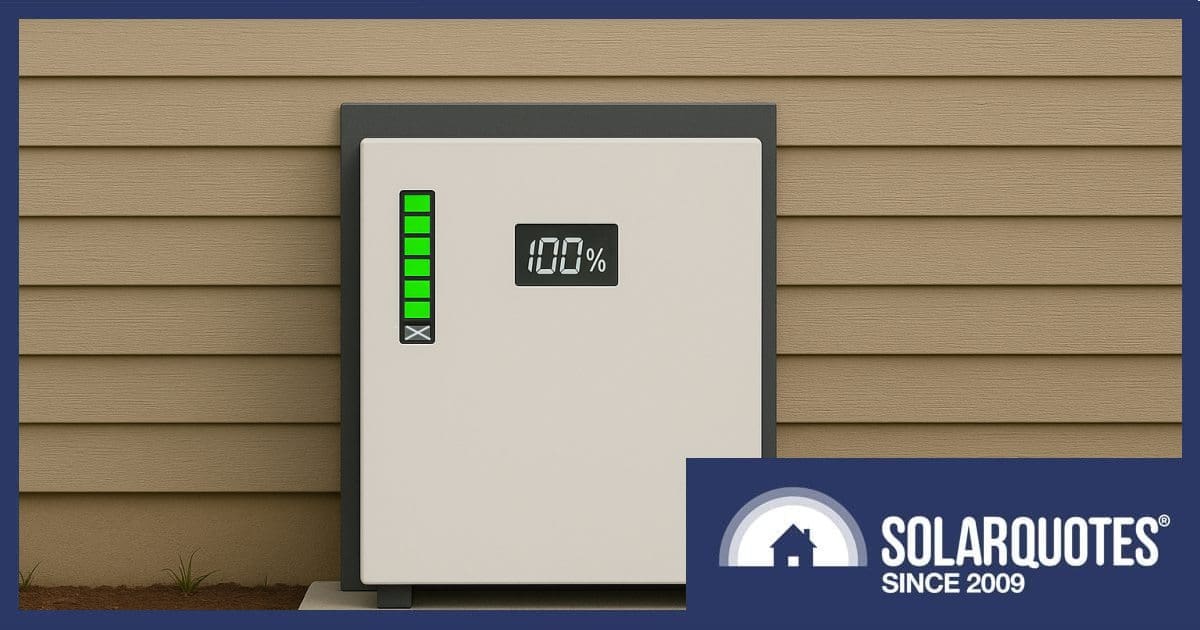
Failing to understand jargon like the difference between ‘nominal’ and ‘useable’ capacity can leave homeowners with less battery storage than expected and even disqualify their batteries from the federal rebate. Here’s what it all means and why it matters.
Scattered among SolarQuotes’ home battery customer reviews of various brands are a few comments from disappointed Australians who didn’t get quite the amount of storage they expected. When determining the size (capacity) of battery you’ll need, it’s important to understand several related terms.
Nominal (Or Total) And Useable Capacity
Nominal or total capacity, described in kilowatt-hours (kWh), is simply the total amount of energy1 a battery can store. Useable capacity is the amount of energy that can actually be accessed for your use.
Using the example of a Sigenergy Sigenstor 5S-13, its datasheet indicates a total capacity of 13.44 kWh, and a useable capacity of 13 kWh. But the difference between nominal and useable capacities in home battery systems varies.
The difference is particularly important to understand if trying to claim the federal battery rebate, for which the nominal (total) capacity of 5 kWh to 100 kWh will be eligible, but only the first 50 kWh of usable capacity is discounted.
Why the difference?
Leaving a small amount of capacity untouched helps to avoid damage to the battery and increase its service life. The good news is you won’t have to do mental gymnastics figuring out how much you can use after it is installed. Whatever the solar battery’s useable capacity is, that’s all you’ll be able to access.
Depth-Of-Discharge (DoD)
But sometimes the useable capacity isn’t specified on a datasheet — just a total or nominal figure, or even just ‘capacity’. If that’s the case, then this is a flag to look for another term: Depth-of-discharge (DoD).
Depth-of-discharge means how much of the total capacity of a battery, expressed as a percentage, is useable. For example, if a 10 kWh battery has a DoD figure of 90%, that means it has 9 kWh of useable capacity. Usually a DoD figure (if present) for a lithium-ion based system will be 90% – 95%. It’s also important to go beyond the datasheet and marketing materials, and closely examine the warranty document as well — more on this in a bit.
Don’t Forget To Factor In Backup Reserve
Many Australians are buying home battery systems for their backup capabilities. Backup reserve allows you to specify how much stored energy is set aside for use during a blackout. This limits the amount of useable capacity you’ll have for day-to-day use.
Using the Sigenstor 5S-13 example again:
- Total capacity: 13.44 kWh
- Useable capacity: 13 kWh
- Backup reserve set to 20% (2.6 kWh)
… this means you’ll have 10.4 kWh to play with. But backup reserve can usually be adjusted in the system’s app — the mySigen app in this case.
Capacity Degradation
Over time, a solar battery’s storage capacity gradually degrades, and some more than others. Another good reason to carefully scrutinise a warranty document is for the performance warranty, which guarantees a battery will retain a certain amount of its nameplate capacity after a specific period or number of charging cycles/energy throughput (usually whichever comes first).
A performance warranty of at least 70% of the battery’s nameplate capacity remaining at the end of a 10-year warranty period isn’t uncommon these days, but there are some models on the SolarQuotes home battery comparison table where the figure is as low as 50% – 60%. If you install a solar battery that only just meets your capacity requirements now, it may not a few years down the track — but that doesn’t mean buying a battery that’s too big to fill.
It’s the responsibility of a solar retailer to clearly explain these terms and recommend a solution that suits your circumstances, providing among other documentation accurate details on expected system performance (and what can affect it) before you sign on the dotted line. Battery manufacturers should also be clear about these aspects in their marketing and datasheets.
But it’s not a perfect world.
Learn about other common battery-buying mistakes to avoid and everything you need to know about choosing the right home battery for you.
Footnotes
- It’s also really important to understand the difference between power and energy. ↩

 RSS - Posts
RSS - Posts



This might seem weaponised but my positive intention is to ensure others are not deceived too, and its the truth.
Sungrow tell lies in its data sheet, with 100% DoD and 100% usable energy stated.
Neither are true.
I was hoodwinked by these, ie, believed it, only to be told after spending a sizable sum that “there is a reserve that is hidden of 5%” in Sungrow’s own words.
Hidden! Hidden alright; from purchasers and only revealed after they try to figure out why their 19.2kwh battery is only delivery 16kwhs.
Of course there is a small amount that must be retained. I knew this. But a data sheet doesnt lie does it and its illegal to make false and misleading statements to induce people to buy, isnt it?
So I assumed it wasn’t stating “nominal” but actual dischargeable capacity. Wrong.
I pointed this out to Sungrow & my retailer over a year ago. The data sheet is unchanged, both continue to market Sungrow SBR batteries with same misleading statements about capacity.
Hi Neil,
You’re not the only person I’ve had complain about Sungrow in this regard. In their defence, sometimes it’s been because a module has failed and needs replacement under warranty.
All batteries rely on a Battery Management System (BMS) to control voltage, current and temperature for lithium batteries & keep them in a safe operating window.
Part of this management is counting kilowatt hours in and out, then making an estimate on State of Charge, because there’s no hard and fast way to determine SoC simply using voltage for instance.
They make a good product and it’s well supported but I’d be happier if Sungrow were honest about a nominal capacity (x cells of x capacity = nominal) and a useable figure, like everyone else in the industry.
Thanks Anthony. All that might be true. But the point is the data sheet is wrong, by sungrows own written admission to me, post purchase.
It says 100% usable when it is 95%, says it has 100% depth of discharge capability when it is only 95%.
Irrespective of where the rest of the energy might go missing or why, there is a 5% shortfall in the amount of energy that is dischargeable from the outset. The rest of the inefficiency loss or losses because of temperature, imbalance of modules, SoH%, etc are compounded from THAT start point of 18.24kWhs not 19.2kWhrs as stated in the datasheet. From this supposed ACTUAL capacity of 19.2 it would be reasonable to assume the nominal capaciry was 20+kWhrs.
As for measurement of it and SoC%, when the battery won’t charge any further despite charging power being available its safe to assume it 100% charged, and similarly when it won’t discharge any further despite there being a load on it. This is how syngrow measure it.
I agree that it’s a good-ish product. Just not happy about being mislead pre purchase.
Yes others may well have commented about this, but at least SQs changed its battery table to account for it, after I pointed it out on an older blog months back.
I can share Sungrow’s email you me stating the 5% reserve, “which is hidden” if you want it.
It also advised about the 2 measuring points, one from BMS and one from inverter.
I don’t trust sungrow. During its last test of my battery, it instructed a discharge when battery was 100% and measured the amount discharged once it reached “0%”, by subtracting gross kWhrs discharged to date at start of test from same at end of test=energy discharged DURING test. Prob was, Sungrow also instructed a charging of battery mid-test, hen recommenced discharge, meaning that kWhr or so of recharge was then discharged and counted as part of the energy discharged.
Incompetence or deliberate. Either way not good. It never explained that to me.
Yes, it’s hard to take somebody seriously when they say their battery has 15kw capacity or their solar system is 10kwh and they are espousing some opinion about home energy.
Also the w is capitalised (kW and kWh) because it references a persons name. James Watt the Scottish engineer that made the steam engine common and started the Industrial Revolution that has lead to the climate crisis we are entering now.
Why is only “W” capitalized?
This follows the SI (International System of Units) conventions:
Unit names are lowercase unless named after a person (e.g., watt → W, newton → N, volt → V)
Prefixes like kilo- use lowercase letters (so k for kilo, M for mega, etc.)
If warranties are based on say 70 % loss of useable ouput based on cycles or throughput where on the app or battery does it have the count for self checking to see how your tracking? Also is it a linear relationship between the degradation and cycles or throughput?
What’s recorded in an integrated hybrid inverter & battery package, and what’s revealed to the user, will doubtless differ between products. Without the BMS-provided cycle details available in my system, I’d have to rely on the battery inverter’s logging. Today’s modest 16.4 kWh solar production – 12.6 kWh consumption = 3. 8 kWh battery charge. Total over 1.5 yrs so far, divided by battery capacity = cycles. But the BMS keeps count, happily. If we review what’s provided, before purchasing, then there are fewer surprises. Otherwise we’ll be more experienced after than before.
With LFP, there is general reference to x% capacity loss p.a., but it can hold better in the first few years, then droop to the average, I hear. We’re all finding out, as there’s only been accelerated testing so far, not real-life 20 year calendar-life experience. I charge mine to a bit under 98%, not 100%, so they may hold a bit better in the short term. Buy ample if funds permit, then it’s all good enough.
One thing i never see discussed with home batteries is the batteries allowed discharge rate. This is a big issue with lithium batteries if one wants to use them to power electric boat motors which can draw 50 or more amps.
I am assuming this is because the allowed discharge rate for home batteries is far in excess of what the inverters used are capable of using?
As commercial battery packs diverge from the traditional 50V, up through 200V toward 800V or so, your assumption increasingly holds. But here, at 50V, just 5 kW is 100A. That’s piffle from a 900 AH bank, but 1/3C from a single 300 AH bank, if that were all to hand. That’s still OK, but now let’s draw 10 kW. That wouldn’t provide power long enough to be fully useful, so we’d install more battery, eliminating both issues.
My brother’s farm buggy EV conversion has a 10 kW motor and just an 80V 100AH battery. But they’re Automotive Grade LFP. Fairly sustained 1C discharge is OK, and 2C surges too. He pulls 100A going up the high steep hill to his house. It’s fine. Just don’t do it with Storage Grade batteries. They’re not selected for lowest internal resistance, so will overheat on heavy work.
There’s a new nearly 600 AH LFP cell from EVE, ~2 kWh in a single cell! A 50V bank of them would laugh at 200A into your boat motor. (Around 170 kg of battery bank is good ballast. 😉
This may be a taboo topic but battery manufacturers have a rather large incentive to boost their “usable battery capacity” in whatever way possible so their battery can maximise incentives.
As the incentives are often based on “usable battery capacity” I’m guessing we’ll be seeing more cases where the depth of discharge is squashed and it’s up to us householders to figure out the actual “usable battery capacity”
I have noticed a tendancy for some specifications to be peak kwh rather than the 70% rms acceptable. Like the old days of stereo hifi – peak versus real capacity. Just imported a few pallets of UPS units- ratings are peak as well. 2200va unit is really 1800. Will need to sticker those
Hi Chris,
Most lightweight hybrid inverters specify a 5kW output with 6kW surge for 10 seconds.
The best ones specify 5kW at 25ºC continuous, 6kW for 30 minutes and 12kW for 30 seconds… so you know what I’ve got for my place.
In any case you need enough battery to make them work properly. Some only offer partial performance if you have the minimum battery connected.